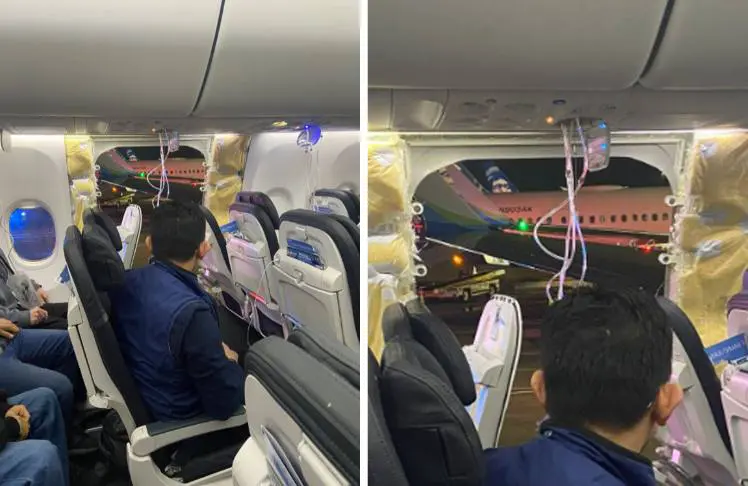
By Chris Isidore, CNN
New York (CNN) — Boeing used to have a reputation for unmatched safety and quality in its commercial jets. No longer.
The terrifying accident aboard a 10-week-old 737 Max 9 flight Friday night is only the latest in what has been a long line of safety and quality control questions about Boeing aircraft. Stunningly, no one was killed or seriously injured when a piece of the plane ripped out of the side of the fuselage only a few minutes into the flight from Portland, Oregon, to Ontario, California, sending some of the contents of the plane hurling into the void.
“It’s fortunate that nobody died and there were not more serious injuries,” Jennifer Homendy, chair of the National Safety Transportation Board (NTSB), told CNN.
Investigators continue to comb through data and eyewitness accounts and examine the jet itself. Early details from the NTSB are harrowing: Homendy said that the headrests from seat 26A — which is immediately next to the refrigerator-sized hole in the plane’s left side — as well as seat 25A in front of it, were missing. Seats structures are twisted, Homendy said, oxygen masks are dangling and there is a piece of clothing caught up in the hole by the missing door plug that separated from the airplane.
“The video looks very calm, but I’m sure it was completely chaotic and very loud,” Homendy said, referring to videos taken by passengers.
The cause of the accident has not been determined. The plane’s auto pressurization fail light had illuminated three times in the past month, Homendy said, noting it is unclear if there is any correlation between the warning lights and the Friday incident.
But the plane was put into service in October. The fact that the plane is essentially brand new suggests it could ultimately be Boeing’s fault and not the maintenance crew at Alaska Airlines, said Richard Aboulafia, managing director at AeroDynamic Advisory, an aerospace and defense management consultancy based in Michigan.
The only good news for Boeing is that “it’s almost certainly not a design issue,” said Aboulafia. But that doesn’t absolve the aircraft maker, he said.
“That leaves us almost certainly with the production process,” he said.
Boeing said it agreed with the Federal Aviation Administration’s (FAA) decision to ground all 737 Max 9 planes while they are inspected.
The FAA, Boeing’s primary regulator, faces intense scrutiny of its own over a recent series of airline delays and near misses between planes, as well as criticism for giving aircraft makers too much freedom to regulate themselves during the certification process.
But the company, for five years, has faced repeated quality and safety issues with its aircraft, leading to the long-term grounding of some jets and the halt in deliveries of others. Boeing’s (BA) stock tumbled nearly 9% in premarket trading Monday as investors grow concerned about more damage to its business.
The most glaring quality problems for Boeing came with the 737 Max’s design, which was judged to be responsible for two fatal crashes: one in Indonesia in October 2018 and the other in Ethiopia in March 2019. Together, the two crashes killed all 346 people aboard the two flights and led to a 20-month grounding of the company’s best-selling jets, which cost it more than $21 billion.
But the design flaws that caused the crashes brought to light questions about the decision making process at Boeing. Internal communications released during the 737 Max grounding showed one employee describing the jet as “designed by clowns, who in turn are supervised by monkeys.”
Two other employees agreed that they would not allow their family members to fly on the plane. Boeing’s release of the documents included an apology to the FAA, Congress, airlines and their passengers.
The company said it would hold an all-employee meeting on Tuesday “focused on safety” at the 737 Max factory in Renton, Washington.
Quality problems go beyond 737 Max
The problems with the Max are only part of the quality control issues that have dogged the company.
It had to twice halt deliveries of its 787 Dreamliner, for about a year starting in 2021 and again in 2023, due to quality concerns cited by the FAA. And the 777 jet also suffered a grounding after an engine failure on a United flight scattered engine debris onto homes and ground below.
Some of those problems, such as the engine issues on the 777, were attributed to Boeing suppliers. But Boeing has worked to cut the costs it pays suppliers in recent years, such as those that make its fuselages and engines. Aboulafia suggested that effort could have contributed to the series of quality control problems with its planes.
The company did not respond to a request for comment on whether the Alaska Airlines flight was linked to Boeing’s recent quality problems.
The problem with the Alaska Airlines 737 Max flight isn’t the first problem since the plane was returned to service three years ago following the grounding. Just this past December, Boeing asked airlines to inspect all of their 737 Max jets for a potential loose bolt in the rudder system, after an airline discovered a potential problem with a key part on two aircraft.
Whenever a new problem occurs, Boeing insists that safety and quality are the company’s number one priority.
“Safety is our top priority and we deeply regret the impact this event has had on our customers and their passengers,” said Boeing after the Alaska Airlines accident.
A lost reputation for safety and quality
It wasn’t long ago that Boeing had an unmatched reputation for quality and safety. “If it’s not Boeing, I’m not going,” used to be an expression to express the trust passengers and airline crews placed in the aircraft maker’s quality.
Boeing still sells T-shirts and coffee mugs bearing that expression, which no longer rings true for many passengers.
It’s not easy to say when things started to change at Boeing. Some aviation industry experts point to a 1997 merger with McDonnnell Douglas that eventually gave the company top executives who were not former engineers as past Boeing leadership had been.
Others point to the decision to move corporate headquarters away from its Pacific Northwest roots, first to Chicago in 2001 and then to Arlington, Virginia, in 2022, near the Pentagon and across the Potomac from Washington, DC.
And Boeing’s quality control problems haven’t been limited to its commercial aircraft unit. Many of its military aircraft have also had quality issues that required the company to take large charges against earnings. The most-high profile of those problems includes two new 747 jets being reconfigured to be the next Air Force One presidential jets. Boeing has disclosed more than $2 billion in losses on those two planes alone.
Its space efforts badly trail those of Elon Musk’s upstart SpaceX, as its Starliner spacecraft designed to carry astronauts to and from the International Space Station has yet to have a crewed flight because of a series of errors, delays and failures. Its first crewed flight is now scheduled for later this year, but that would come four years after SpaceX first carried astronauts to the space station.
Quality issues hit bottom line
As recently as 2019, the company was reporting strong sales and profits, topping $100 billion in revenue for the first, and maybe only, time in its history. But it has fallen badly behind rival Airbus since then, especially in the key market for single-aisle jets, such as the 737 Max.
Some problems are beyond its control, such as the China-US trade tensions killing demand for its jets in the crucial China market. But many of these quality problems have angered airline customers, which have grown frustrated by the delays and groundings affecting their own expansion plans.
In 2022, Michael O’Leary, CEO of Ryanair, Europe’s largest discount carrier and a key Boeing customer, let loose a public expletive-filled rant at Boeing management, saying they needed to “get their s*** together” and that company executives need either an immediate “reboot, or a boot up the a**.”
The delivery and production problems have resulted in the company reporting only one profitable quarter since 2019, and it’s not clear when it will report an annual profit again.
The fact that Boeing and Airbus are the only two major global aviation companies means that Boeing probably doesn’t have to worry about being forced out of business, no matter how extensive its mistakes. Neither company could accommodate all commercial aircraft demand, and both have a backlog of orders stretching back years.
But the problems have meant that Boeing continues to fall further behind Airbus.
Boeing had to postpone plans for its next-generation jet, popularly known as the Boeing 797, which was supposed to offer airlines a mid-size, long-distance jet to compete with the Airbus A321XLR. And it has delayed plans to begin production of the next version of the 777, the 777X, which was originally due to start delivery to customers by the end of last year. Now Boeing won’t be delivering the first 777X until at least 2025.
– CNN’s Pete Muntean, Gregory Wallace and Jackie Wattles contributed to this report
The-CNN-Wire
™ & © 2024 Cable News Network, Inc., a Warner Bros. Discovery Company. All rights reserved.















